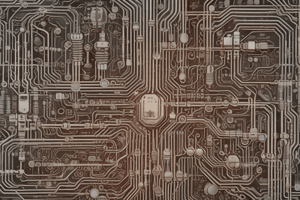Podcast
Questions and Answers
What is the primary function of a capacitor in a circuit?
What is the primary function of a capacitor in a circuit?
- To store electrical energy (correct)
- To oppose current flow
- To amplify signals
- To protect against overcurrent
A diode allows current to flow in both directions.
A diode allows current to flow in both directions.
False (B)
What unit is used to measure a resistor?
What unit is used to measure a resistor?
Ohms
A _____ is a device that transfers electrical energy between circuits through electromagnetic induction.
A _____ is a device that transfers electrical energy between circuits through electromagnetic induction.
Which type of transistor is commonly used to amplify electronic signals?
Which type of transistor is commonly used to amplify electronic signals?
Match the following circuit components with their primary functions:
Match the following circuit components with their primary functions:
What is the role of a fuse in an electrical circuit?
What is the role of a fuse in an electrical circuit?
A _____ source provides a constant current regardless of the voltage.
A _____ source provides a constant current regardless of the voltage.
Flashcards are hidden until you start studying
Study Notes
Circuit Components in Power Engineering
-
Resistor
- Opposes current flow, dissipates energy as heat.
- Measured in Ohms (Ω).
- Types: fixed, variable, and specialty resistors.
-
Capacitor
- Stores electrical energy in an electric field.
- Measured in Farads (F).
- Types: ceramic, electrolytic, tantalum, and film capacitors.
- Used for filtering, coupling, and timing applications.
-
Inductor
- Stores energy in a magnetic field when current flows through it.
- Measured in Henries (H).
- Commonly used in filters, transformers, and energy storage applications.
-
Transformer
- Transfers electrical energy between circuits through electromagnetic induction.
- Generally used for voltage level adjustments (step-up or step-down).
- Consists of primary and secondary windings.
-
Diode
- Allows current to flow in one direction only; acts as a one-way valve for electric current.
- Used for rectification, signal modulation, and voltage regulation.
- Types: standard, Zener, Schottky, and light-emitting diodes (LEDs).
-
Transistor
- Semiconductor device used to amplify or switch electronic signals.
- Types: Bipolar Junction Transistor (BJT) and Field Effect Transistor (FET).
- Essential for signal processing and control applications.
-
Voltage Source
- Provides a constant voltage to a circuit.
- Types: batteries, power supplies, and generators.
- Characterized by voltage rating and current capacity.
-
Current Source
- Supplies a constant current regardless of voltage.
- Essential in applications where current needs to be controlled.
-
Switch
- Controls the flow of current in a circuit by opening (off) or closing (on) the circuit path.
- Types: mechanical switches, relays, and solid-state switches.
-
Fuse
- Protects circuits from overcurrent by breaking the circuit when excessive current flows.
- Available in various ratings based on current capacity.
-
Circuit Breaker
- Automatically interrupts the flow of current in overcurrent conditions, providing reusable protection.
- Can be reset manually or automatically.
-
Load
- Any device or component that consumes electrical power, such as motors, lights, and resistive heaters.
- Loads can be resistive, inductive, or capacitive.
-
Ground
- Provides a common return path for electric current and a safety measure to prevent electric shock.
- Types: earth ground, chassis ground, and signal ground.
Summary
Understanding circuit components is crucial in power engineering for designing, analyzing, and troubleshooting electrical circuits. Each component serves a specific role in controlling and manipulating electrical energy.
Circuit Components in Power Engineering
-
Resistor
- Opposes current flow and dissipates energy as heat, measured in Ohms (Ω).
- Available in fixed, variable, and specialty types for diverse applications.
-
Capacitor
- Stores electrical energy in an electric field, measured in Farads (F).
- Types include ceramic, electrolytic, tantalum, and film, commonly used for filtering, coupling, and timing.
-
Inductor
- Stores energy in a magnetic field with current flow, measured in Henries (H).
- Frequently utilized in filters, transformers, and energy storage applications.
-
Transformer
- Transfers electrical energy between circuits through electromagnetic induction.
- Primarily used to adjust voltage levels, consisting of primary and secondary windings.
-
Diode
- Functions as a one-way valve allowing current to flow in a single direction.
- Essential for rectification and signal modulation, with types including standard, Zener, Schottky, and LEDs.
-
Transistor
- A semiconductor device used for amplifying or switching electronic signals.
- Includes Bipolar Junction Transistors (BJT) and Field Effect Transistors (FET), critical for signal processing and control.
-
Voltage Source
- Provides a constant voltage to a circuit, with types including batteries, power supplies, and generators.
- Characterized by voltage rating and current capacity.
-
Current Source
- Supplies a constant current irrespective of voltage, crucial for controlled current applications.
-
Switch
- Controls the flow of current by either opening or closing the circuit path.
- Types include mechanical switches, relays, and solid-state switches.
-
Fuse
- Protects circuits from overcurrent by breaking the circuit when an excessive flow occurs.
- Comes in various ratings based on current capacity.
-
Circuit Breaker
- Automatically interrupts current flow during overcurrent conditions, offering reusable protection.
- Can be manually or automatically reset after activation.
-
Load
- Refers to devices or components that consume electrical power, such as motors, lights, and heaters.
- Loads can be classified as resistive, inductive, or capacitive.
-
Ground
- Serves as a common return path for electric current and a crucial safety measure against electric shock.
- Common types include earth ground, chassis ground, and signal ground.
Summary
Understanding circuit components is essential for effective design, analysis, and troubleshooting in power engineering, as each component plays a vital role in the management of electrical energy.
Studying That Suits You
Use AI to generate personalized quizzes and flashcards to suit your learning preferences.




